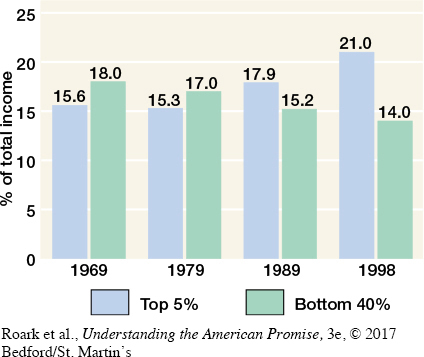The Booming Economy of the 1990s
Clinton’s ability to weather impeachment owed much to the prosperous economy, which in 1991 began a period of tremendous expansion. During the 1990s, the gross domestic product grew by more than one-third, thirteen million new jobs were created, inflation remained in check, unemployment reached 4 percent—its lowest point in twenty-five years—and the stock market soared.
Clinton’s policies contributed to the boom. He made deficit reduction a priority, and in exchange the Federal Reserve Board and bond market traders encouraged economic expansion by lowering interest rates. Businesses also prospered because they had lowered their costs through corporate restructuring and employee layoffs. Economic problems in Europe and Asia helped American firms become more competitive in the international market. And the computer revolution and the application of information technology boosted productivity.
People at all income levels benefited from the economic boom, but income inequality, rising since the 1970s, endured (Figure 31.1). The growing use of computer technology increased demand for highly skilled workers, while the movement of manufacturing jobs abroad diminished opportunities and wages for the less skilled. Moreover, deregulation and the continuing decline of unions hurt lower-skilled workers, tax cuts favored the better-off, and the minimum wage failed to keep up with inflation. [[LP Figure: F31.01 The Growth of Inequality: Changes in Family income, 1969–1998/

Although more minorities than ever attained middle-class status, people of color overall remained lowest on the economic ladder. For instance, in 1999 the median income for white households surpassed $45,000, but it stood at only $29,423 and $33,676 for African American and Latino households, respectively. In 2000, poverty afflicted more than 20 percent of African Americans and Latinos, in contrast to 7.5 percent of whites.
> QUICK REVIEW
What policies of the Clinton administration moved the Democratic Party to the right?
Understanding the American Promise 3ePrinted Page 896
Section Chronology